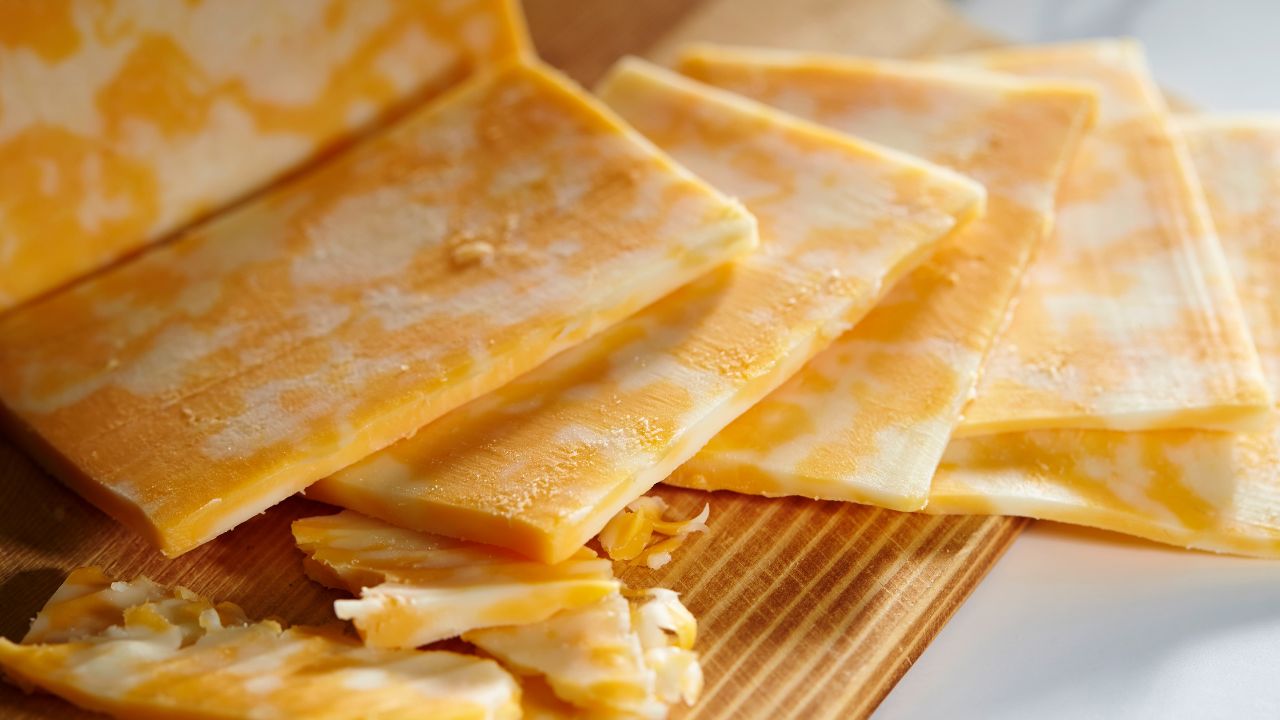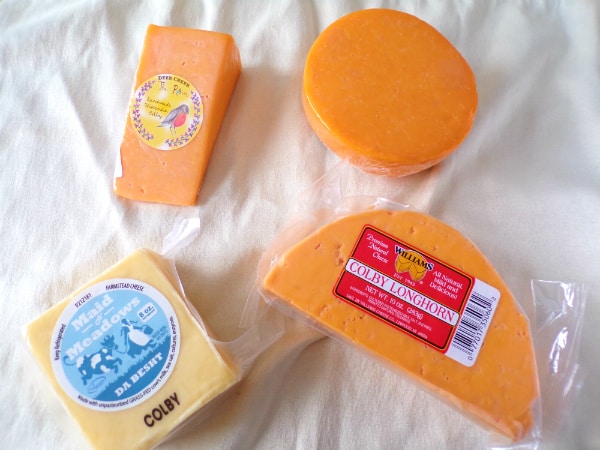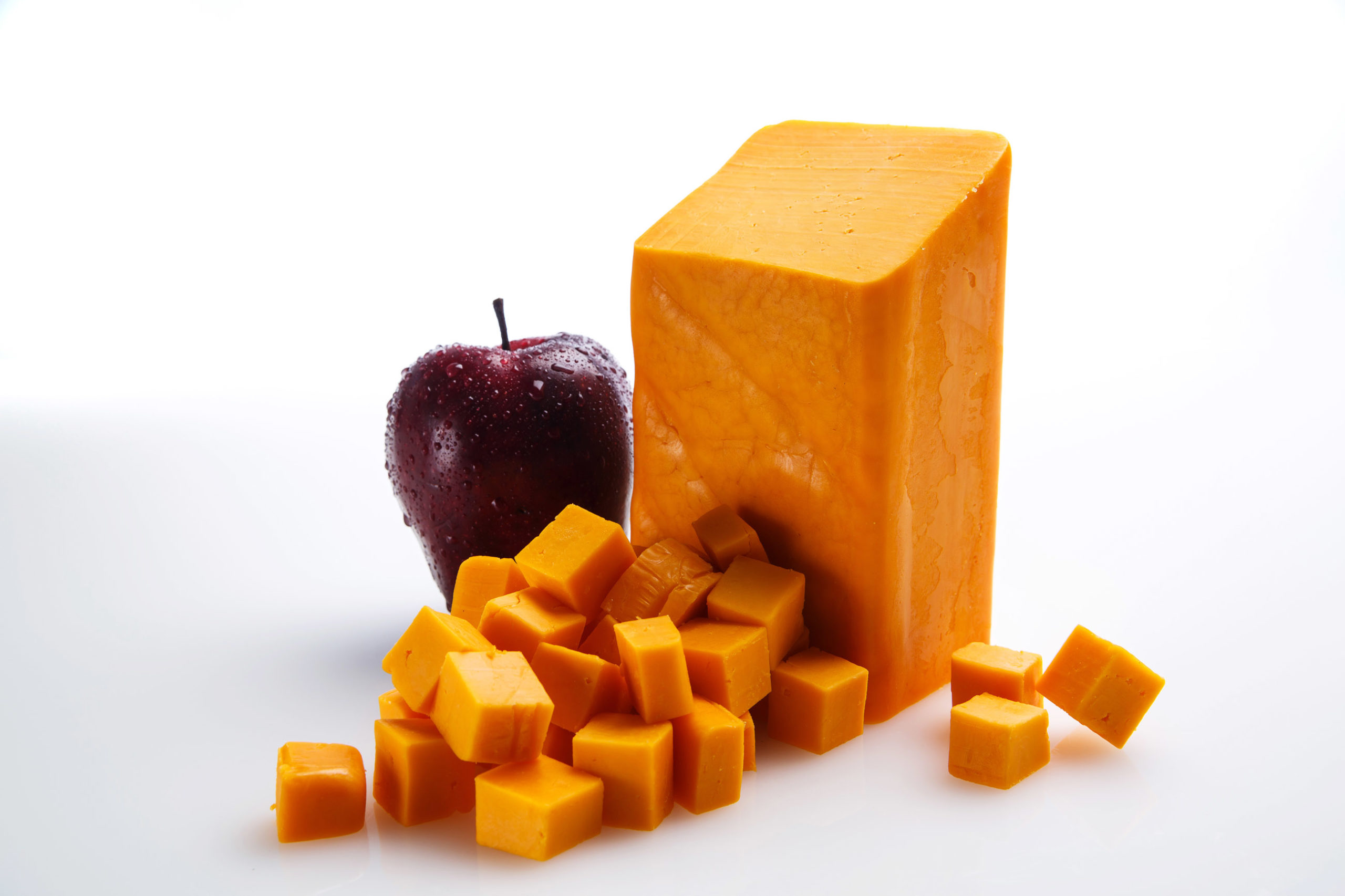Cheddar Vs Colby: Introduction To Cheese Varieties

Cheddar and Colby are two popular cheese varieties known for their distinct flavors and textures. Cheddar cheese originates from England and is widely loved for its sharp and tangy taste. On the other hand, Colby cheese hails from Wisconsin in the United States and is recognized for its milder, sweeter flavor. While both cheeses are made from cow’s milk and have a creamy texture, they differ in terms of aging and the cheesemaking process. Understanding the characteristics of these cheeses can enhance your culinary experience and help you choose the perfect cheese for your next recipe or cheese board.
Cheddar And Colby Cheese: Origins And Characteristics
Cheddar cheese originated in England and is known for its sharp and tangy flavor. It is made from cow’s milk and undergoes a process called cheddaring, which involves stacking and flipping the curds to create a dense texture. Cheddar is aged for different periods, ranging from a few months to several years, resulting in a variety of flavors and intensities. On the other hand, Colby cheese was developed in Wisconsin, USA. It has a milder and sweeter taste compared to Cheddar and is made by rinsing the curds with cold water, giving it a softer texture.
Cheddar Cheese Profile
Cheddar cheese is a popular variety known for its rich, sharp, and tangy flavor. It is made from cow’s milk and undergoes a process called cheddaring, which involves stacking and flipping the curds to create a dense texture. Cheddar cheese comes in a range of ages, from mild to extra sharp, allowing for varying levels of intensity in flavor. It has a smooth and creamy texture when young, but as it ages, it becomes crumbly and develops a more pronounced flavor. Cheddar cheese is versatile and can be used in a wide range of dishes, from sandwiches to macaroni and cheese.
Cheddar Cheese Flavor And Texture

Cheddar cheese is renowned for its rich, sharp, and tangy flavor. The taste can vary depending on the age of the cheese, ranging from mild to extra sharp. Young cheddar has a smooth and creamy texture, while aged cheddar becomes crumbly and develops a more pronounced flavor. Its texture is dense and firm, making it perfect for slicing or shredding. The aging process gives cheddar its unique flavor profile, with notes of nuttiness and hints of sweetness. Its robust flavor and versatile texture make cheddar a beloved cheese choice for various culinary applications.
Cheddar Cheese Culinary Uses
Cheddar cheese is incredibly versatile and widely used in various culinary applications. Its robust flavor and firm texture make it a popular choice for many dishes. Here are some common uses for cheddar cheese:
- Sandwiches and Burgers: Cheddar cheese adds a delicious tanginess to sandwiches and burgers, melting into the fillings and enhancing the overall flavor.
- Macaroni and Cheese: Cheddar is a classic choice for macaroni and cheese, providing a creamy and cheesy base.
- Cheeseburgers: Cheddar cheese is often used to top off a juicy cheeseburger, adding a rich and melty layer of flavor.
- Cheeseboards: Cheddar adds depth to a cheeseboard, pairing well with fruits, nuts, and crackers.
- Casseroles and Quiches: Cheddar cheese can be added to casseroles and quiches, giving them a cheesy and savory twist.
- Soups: Cheddar cheese can be used to thicken and flavor soups, such as broccoli cheese soup or potato cheese soup.
- Grilled Cheese: Cheddar is a classic choice for making a gooey and delicious grilled cheese sandwich.
By incorporating cheddar cheese into these dishes and more, you can enjoy its bold flavor and creamy texture in a variety of culinary creations.
Colby Cheese Profile
Colby cheese is a variety of cheese that is known for its mild and creamy flavor. It originated in Wisconsin, USA, and is named after the town of Colby. This cheese is made from cow’s milk and has a smooth and elastic texture. Colby cheese has a pale yellow color and a slightly tangy taste. It is often described as being sweeter and less acidic compared to young cheddar cheese. Colby cheese is typically aged for a shorter period of time, resulting in a milder flavor profile. It is commonly used in sandwiches, salads, and as a topping for burgers.
Colby Cheese Flavor And Texture

Colby cheese has a distinct flavor and texture that sets it apart from other cheese varieties. It is known for its mild and creamy taste with a slightly tangy undertone. Compared to young cheddar cheese, Colby has a sweeter flavor profile. The texture of Colby cheese is smooth and elastic, making it easy to slice and melt. It has a pale yellow color and a more open texture compared to cheddar cheese. The combination of its smooth texture and mild flavor makes Colby cheese a favorite for snacking, sandwiches, and salads.
Colby Cheese Culinary Uses
Colby cheese is a versatile ingredient that can be used in a variety of culinary applications. Its smooth and creamy texture makes it perfect for melting, which is why it is often used in dishes like grilled cheese sandwiches, macaroni and cheese, and cheeseburgers. It can also be grated and used as a topping for casseroles, soups, and salads. Additionally, Colby cheese pairs well with fruits, crackers, and bread, making it a popular choice for cheese platters and charcuterie boards. Its mild flavor also makes it a great choice for snacking and enjoying on its own.
Contrasting Cheddar And Colby Cheeses
Cheddar and Colby cheeses may seem similar at first glance, but they have distinct differences in flavor and texture. Cheddar cheese is known for its sharp and tangy taste, while Colby cheese has a milder and sweeter flavor. The texture of cheddar is crumbly and creamy, while Colby cheese has a softer and more elastic texture. These variations can be attributed to the differences in the cheesemaking process, such as the rinsing of curds for Colby with cold water, while cheddar is not rinsed. These factors contribute to the contrasting characteristics of cheddar and Colby cheeses.
Differences In Flavor Profiles

Cheddar and Colby cheeses have distinct flavor profiles that set them apart. Cheddar cheese is renowned for its sharp and tangy taste, with a complex and robust flavor. On the other hand, Colby cheese has a milder and sweeter flavor, making it more approachable for those who prefer a less intense taste. The differences in the flavor of these cheeses can be attributed to the cheesemaking process, such as the rinsing of curds for Colby with cold water and the aging process. These variations in flavor offer a range of options for cheese lovers with different preferences.
Texture Variations
Texture plays a significant role in distinguishing cheddar and Colby cheeses. Cheddar cheese has a smooth and dense texture, with a crumbly and slightly granular feel. As it ages, cheddar becomes drier and more crumbly. Colby cheese, on the other hand, has a softer and more elastic texture. It is less crumbly and has a springy and creamy mouthfeel. These differences in texture contribute to the distinct eating experience of each cheese. Whether you prefer a crumbly and dense texture or a softer and more elastic one, both cheddar and Colby cheese offer unique sensations to enjoy.
Pairing And Serving Suggestions
Pairing and serving suggestions can enhance the enjoyment of both cheddar and Colby cheeses. For cheddar cheese, it pairs well with fruits like apples and pears, as well as nuts like walnuts and almonds. It also complements savory items like cured meats and pickles. As for Colby cheese, it pairs nicely with mild-flavored foods such as crackers, bread, and deli meats. For serving, both cheeses are great options for cheese boards, sandwiches, and macaroni and cheese. They can also be melted for use in fondue or grilled cheese sandwiches. Whichever way you choose to serve them, cheddar and Colby cheeses provide delicious versatility for a variety of dishes.
Best Combinations For Cheddar And Colby Cheeses

Cheddar and Colby cheeses offer delectable pairings that enhance their flavors. For cheddar cheese, it pairs wonderfully with fruits like apples and pears, as well as nuts such as walnuts and almonds. It also complements savory items like cured meats and pickles. On the other hand, Colby cheese pairs nicely with mild-flavored foods like crackers, bread, and deli meats. Both cheeses are excellent choices for cheese boards, sandwiches, and macaroni and cheese. They can even be melted for use in fondue or grilled cheese sandwiches. The versatility of cheddar and Colby cheeses makes them ideal for a variety of dishes.
Cheese Board Tips For Entertaining
When hosting a gathering or a party, a cheese board can be a delightful addition to the spread. Follow these tips to create a visually appealing and delicious cheese board for your guests:
- Variety is key: Include a selection of cheddar and Colby cheeses, along with other varieties such as brie, gouda, or blue cheese. This ensures there’s something for everyone’s taste.
- Texture and color contrast: Add a mix of soft, creamy cheeses and harder, aged cheeses for a textural contrast. Incorporate colorful fruits like grapes, berries, or figs for a visually appealing display.
- Accompaniments: Provide an assortment of crackers, breads, and sliced baguette to pair with the cheeses. Include a variety of condiments such as honey, chutney, or mustard for added flavor.
- Garnish with nuts and herbs: Sprinkle toasted nuts like almonds or walnuts around the cheese board. Fresh herbs like rosemary or basil can also be used as garnish for an aromatic touch.
- Label the cheeses: Place small signs or labels beside each cheese to indicate its type. This helps guests differentiate between the different cheeses and appreciate their flavors.
- Serve at room temperature: Take the cheeses out of the refrigerator at least 30 minutes before serving to allow them to reach their optimal flavor and texture.
- Presentation: Arrange the cheeses and accompaniments in an aesthetically pleasing manner. Consider using a wooden or marble cheese board and add cheese knives for easy serving.
- Pairing suggestions: Provide a list of suggested pairings, such as specific fruits, nuts, or cured meats that complement each cheese. This helps guide guests in creating their own flavor combinations.
Remember, a cheese board is not only delicious, but it also serves as a centerpiece for your gathering, enticing guests with its colors, textures, and flavors. Enjoy the process of creating a beautiful and enticing cheese board that will leave a lasting impression on your guests.
Conclusion
In conclusion, understanding the differences between Cheddar and Colby cheeses allows for a more informed culinary experience. Cheddar cheese offers a bold and sharp flavor with a crumbly texture, making it perfect for melting and adding depth to dishes. On the other hand, Colby cheese has a milder and creamier taste, ideal for snacking and sandwiches. Whether you prefer the robustness of Cheddar or the subtle creaminess of Colby, both cheeses have their unique qualities that can enhance a wide range of recipes. So, explore the world of cheese and discover the multitude of flavors and textures it has to offer.
Key Takeaways From Cheddar Vs Colby Comparison

In conclusion, when comparing Cheddar and Colby cheeses, there are several key takeaways to keep in mind.
- Flavor: Cheddar cheese has a bold and sharp taste, while Colby cheese is milder and smoother.
- Texture: Cheddar cheese has a crumbly texture, while Colby cheese is creamier.
- Culinary Uses: Cheddar cheese is great for melting and adding depth to dishes, while Colby cheese is ideal for snacking and sandwiches.
- Pairings: Cheddar cheese pairs well with fruits, nuts, and dark breads, while Colby cheese goes well with crackers and light breads.
Overall, both Cheddar and Colby cheeses offer their own unique qualities that can enhance a variety of recipes and culinary experiences.
FAQ About Cheddar Vs Colby: Contrasting Cheese Flavors
Q: What is the main difference between Cheddar and Colby cheese?
A: The main difference between Cheddar and Colby cheese lies in their flavor profile. Cheddar cheese has a sharp, rich taste, while Colby cheese has a milder, creamier flavor.
Q: Are there any variations in the texture of Cheddar and Colby cheese?
A: Yes, Cheddar cheese is known for its crumbly and dense texture, whereas Colby cheese is softer and semi-soft in texture.
Q: Can Cheddar and Colby cheese be used interchangeably in recipes?
A: While both Cheddar and Colby cheese melt well and can be used in similar dishes, their distinct flavors may affect the final taste of the recipe. It is best to use them based on personal preference or recipe requirements.
Q: Which cheese is more commonly used in cooking – Cheddar or Colby?
A: Cheddar cheese is more commonly used in cooking due to its robust flavor, which can add depth to dishes. Colby cheese is often preferred for its mild taste, making it suitable for dishes where a subtler flavor is desired.
Q: Can Cheddar and Colby cheese be paired with different ingredients?
A: Yes, both Cheddar and Colby cheese pair well with a variety of ingredients, but the choice may depend on the dish. Cheddar’s bold flavor complements strong flavors like meats and sauces, while Colby’s mild taste enhances lighter ingredients like fruits and nuts.
Q: Are there any nutritional differences between Cheddar and Colby cheese?
A: Both Cheddar and Colby cheese are good sources of calcium and protein, but Cheddar cheese typically has a higher fat content than Colby cheese. It is important to consider nutritional values when choosing between the two for a balanced diet.
Q: How should Cheddar and Colby cheese be stored to maintain freshness?
A: To maintain freshness, both Cheddar and Colby cheese should be wrapped tightly in wax paper or plastic wrap and stored in the refrigerator. It is advisable to keep them away from moisture and odors to prevent spoilage.

Marine Bay Restaurant received the International Food Culture Award 2019 as the Best Szechuan & Hunan Restaurant, enjoying a reputation in North America. Renowned for the tunnel, authentic, and cheap. Known as “Human Taste First Garden,” 2013 Vancouver culinary first book named “Best Chuan Xiang Outlets,” significant temperature and China Eastern Airlines designated outlets.